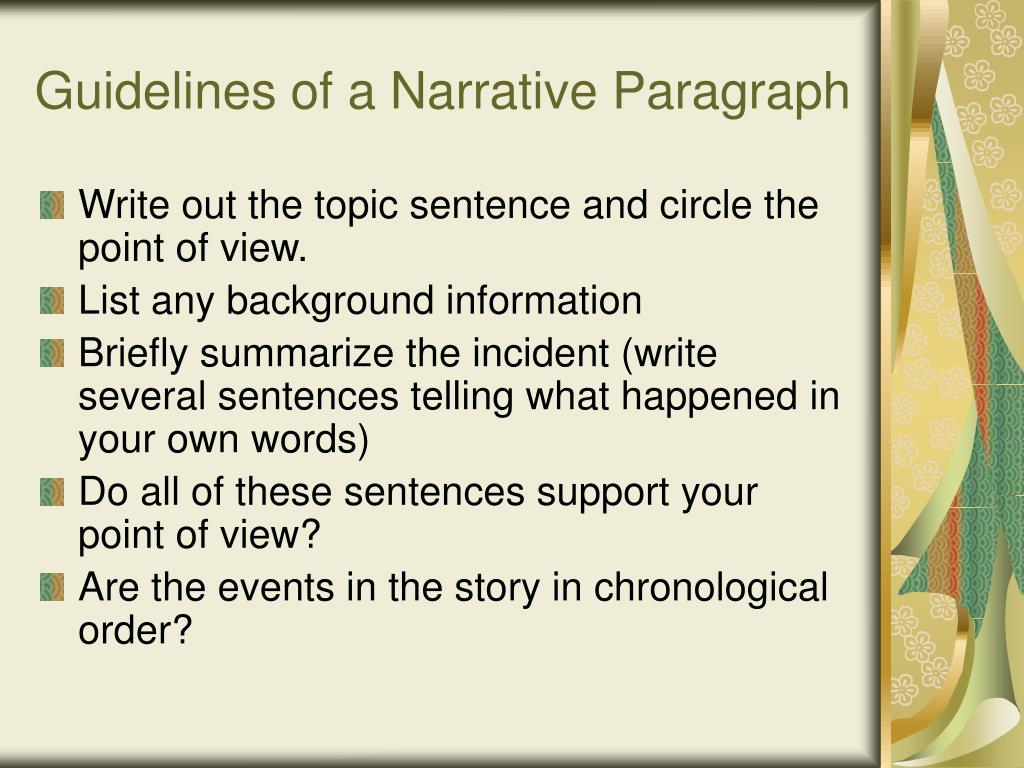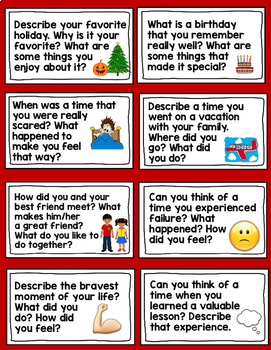
· A narrative essay most often tells a story from the writer's perspective. The essay defines a specific point of view. All this means is that the narrative essay tells the story how you see it. Ever A narrative essay gives writers a chance to write about their personal experiences. It is just like a short story; the only difference is, it follows a proper structure. When you write a narrative essay, you tell a story to your reader. The story could be real, or it could be · • Narrative paragraph tells a story or an event. • It could be tale, novel, an account of one’s life, natural phenomena, or social events • The story/events in narrative paragraph should be arranged chronologically (time order), that is in the order in which they have happened. 5
What Is the Definition of a Narrative Paragraph?
The definition of narrative is a piece of writing that tells a story, narrative paragraph definition, and it is one of four classical rhetorical modes or ways that writers use to present information. The others include an exposition, which explains and analyzes an idea or set of ideas; an argument, which attempts to persuade the reader to a particular point of view; and a description, a written form of a visual experience.
Telling stories is an ancient art that started long before humans invented writing. People tell stories when they gossip, tell jokes, or reminisce about the past. Written forms of narration include most forms of writing: personal essays, fairy tales, short stories, novels, plays, screenplays, autobiographies, narrative paragraph definition, histories, even news stories have a narrative.
Narratives may be a sequence narrative paragraph definition events in chronological order or an imagined tale with flashbacks or multiple timelines. Every narrative has five elements that define and shape the narrative: plot, setting, characterconflictand theme, narrative paragraph definition.
These elements are narrative paragraph definition stated in a story; they are revealed to the readers in the story in subtle or not-so-subtle ways, but the writer needs to understand the elements to assemble her story.
Here's an example from "The Martian," a novel by Andy Weir that was made into narrative paragraph definition film:. In addition to structural elements, narratives have several styles that help move the plot along or serve to involve the reader.
Writers define space and time in a descriptive narrative, and how they choose to define those characteristics can convey a specific mood or tone. For example, chronological choices can affect the reader's impressions.
Past events always occur in strict chronological order, but writers can choose to mix that up, show events out of sequence, or the same event several times experienced by different characters or described by different narrators.
In Gabriel García Márquez's novel "Chronicle of a Death Foretold," the same few hours are experienced in sequence from narrative paragraph definition viewpoint of several different characters. García Márquez uses that to illustrate the peculiar almost magical inability of the townspeople to stop a murder they know is going to happen. The choice of a narrator is another way that writers set the tone of a piece.
Is the narrator someone who experienced the events as a participant, or one who witnessed the events but wasn't an active participant? Is that narrator an omniscient undefined person who knows everything about the plot including its ending, or is he confused and uncertain about the events underway? Is the narrator a reliable witness or lying to themselves or the reader? In the novel "Gone Girl," by Gillian Flynn, the reader is forced to constantly revise her opinion as to the honesty and guilt of the husband Nick and his missing wife.
In "Lolita" by Vladimir Nabokov, the narrator is Humbert Humbert, a pedophile who constantly justifies his actions despite the damage that Nabokov illustrates he's doing, narrative paragraph definition. Establishing a point of view for a narrator allows the writer to filter the events through a particular character. The most common point of view in fiction is the omniscient all-knowing narrator who has access to all the narrative paragraph definition and experiences of each of her characters.
Omniscient narrators are almost always written in the third person and do not usually have a role in the storyline. The Harry Potter novels, narrative paragraph definition example, are all written in third person; that narrator knows everything about everybody but is unknown to us.
The other extreme is a story with a first-person point of view in which the narrator is a character within that story, relating events as they see them and with no visibility into other narrative paragraph definition motivations. Charlotte Bronte's "Jane Eyre" is an example of this: Jane relates her experiences of the mysterious Mr. Rochester to us directly, not revealing the full explanation until "Reader, I married him, narrative paragraph definition. Points of view can also be effectively shifted throughout a piece—in her novel "Keys to the Street," Ruth Rendell used limited third-person narratives from the point of view of five different characters, enabling the reader to assemble a coherent whole out of what first appears to be unrelated stories.
Writers also use the grammatical strategies of tense past, present, futureperson first person, second person, third personnumber singular, plural and voice active, passive. Writing in the present tense is unsettling—the narrators have no idea what will happen next—while past tense can build narrative paragraph definition some foreshadowing.
Many recent novels use the present tense, including "The Martian. In "Moby Dick," the entire story is told by the narrator Ishmael, who relates the tragedy of the mad Captain Ahab, and is situated as the moral center.
White, writing columns in 's "New Yorker" magazine, often used the plural or "editorial we" to add a humorous universality and a slow pace to his writing. In contrast, sportswriter Roger Angell White's stepson epitomizes sports writing, with a quick, active voice, and straight chronological snap:.
Share Flipboard Email, narrative paragraph definition. English English Grammar An Introduction to Punctuation Writing. Richard Nordquist. English and Rhetoric Professor. Richard Nordquist is professor emeritus of rhetoric and English at Georgia Southern University and the author of several university-level grammar and composition textbooks. our editorial process.
Updated January 20, Key Takeaways: Narrative Definition A narrative is a form of writing that tells a story. Narratives can be essays, fairy tales, movies, and jokes. Narratives have five elements: plot, setting, character, conflict, and theme. Writers use narrator style, chronological order, a point of view, and other strategies to tell a story.
Cite this Article Format. Nordquist, Richard. Definition and Examples of Narratives in Writing. copy citation. A Guide to All Types of Narration, Narrative paragraph definition Examples. Understanding Point of View in Literature. Point of View in Grammar and Composition. How to Write a Narrative Essay or Speech.
Organizational Strategies for Using Chronological Order in Writing. What Are the Parts of a Short Story? How to Write Them. What Is Narrative Therapy? Definition and Techniques. What Is Narrative Poetry? Definition and Examples. How to Write Interesting and Effective Dialogue.
Personal Narrative - Introduction
, time: 4:38Narrative Paragraphs - Learn American English Online

A narrative essay gives writers a chance to write about their personal experiences. It is just like a short story; the only difference is, it follows a proper structure. When you write a narrative essay, you tell a story to your reader. The story could be real, or it could be Narrative paragraphs are the building blocks you need to tell a story in English. This type of paragraph explains something that happened. Think about a time that a friend or family member came to you and said, “guess what!”. They probably then told you a story about something that happened to them. This is what a narrative paragraph is, but in written form Narrative Paragraph: In narrative paragraphs stories are narrated to get the point across. They keep the audience interested by telling a compelling story. Purpose: The purpose is to share your insight about the event, create a shared sense of history, or just try to entertain. How to write a Narrative paragraph

No comments:
Post a Comment